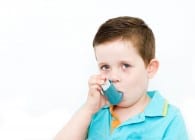Developing An Asthma Crisis Plan
If your child has asthma, you should be well trained by your pediatrician and prepared with the appropriate medications in case an asthma attack or flare-up occurs. Such a plan must be determined beforehand in your doctor’s office. Don’t wait until your child has an attack and then call the doctor’s office for advice. Here is how you can determine the severity of an attack and what appropriate measures can be taken.
HOW TO DETERMINE THE SEVERITY OF AN ATTACK
- Remain calm. Calm your child down.
- Evaluate the breathing. Take your child’s shirt off and observe his chest:
- Are there retractions (the chest sucking in below the ribs or at the base of the neck)? Are the retractions barely visible or very deep and obvious?
- Is your child breathing fast and heavy, using his shoulders to try to get deep enough breaths?
- Count the number of breaths he takes in 15 seconds. Multiply this by four. This tells you how many breaths per minute. If it is over 60 in infants to age two, over 50 in young children to age eight, or over 40 in older children, this is too fast.
- Is there audible wheezing? Is it very mild or very louder and tight sounding? Some children can even be so tight during an attack that not enough air is even moving in and out to make a wheezing noise.
- Check the peak flow several times. Dr. Sears suggest to color-code the wheezing:
- Green Light (Don’t worry.) If it is 80% – 100% of normal, that is a good sign.
- Yellow Light (Worry, start medicines.) If it is 50% – 80% of normal, then your child needs home treatments.
- Red Light (Seek medical help now!) If it is less than 50% of normal, then your child needs more treatments and medical attention.
- Give albuterol treatment. If things seem mild, use the inhaler. If more severe, us a nebulizer if you have one.
- Observe your child. Albuterol sometimes doesn’t take effect for 15 minutes.
- Has the breathing slowed down?
- Have the retractions become less pronounced?
- Has the wheezing improved?
- Is the breathing less labored?
- Re-check the peak flow after half an hour. Use the color-code system again!
- If it has improved, you can be reassured. If it has not improved, consider how your child is doing overall. If you see overall improvement, continue albuterol treatments every 2 – 4 hours as needed until he is stable.
- If you don’t see much improvement, repeat the albuterol inhalation. Most prescriptions will say to only use every 4 hours, but it is okay to use it several times in one or two hours to overcome a bad attack.
- Taking oral steroids. There are two situations where your child may need to take oral steroids for 3 – 5 days to overcome an attack:
- If an attack stays moderate for more than 12 – 18 hours – Your child seems to need treatments every 3 or 4 hours, and the wheezing keeps getting worse again when treatments wear off.
- If a mild attack persists for more than 5 days – Your child is doing ok, but seems to need treatments 3 – 4 times a day as wheezing and other symptoms recur.
WHEN TO GO TO THE EMERGENCY ROOM OR CALL YOUR DOCTOR
- If you still don’t see any improvement after two or three treatments, and the attack is still severe, you should go to an emergency room or your doctor’s office right away.
- In addition, if at any time you notice your child’s lips are blue, go to an emergency room right away. This could be a sign the lungs are so closed off that not enough oxygen is getting into your child.
- If your child’s mental status is lowered – lethargic, won’t focus on you, confused speech. This could also be a sign of inadequate oxygen.
- If at any time you are not sure about your child’s status, call your doctor.
FREQUENT FOLLOW UP WITH YOUR DOCTOR
One of the keys to understanding, preventing, and controlling asthma is regular follow up appointments with your pediatrician. Don’t expect to have your child’s asthma completely evaluated all in one visit. It may take several visits for your doctor to adequately educated you on asthma prevention, find the right maintenance medications for your child, teach you about medications, and go over an appropriate asthma crisis plan with you. If your child is on daily maintenance medications, periodic visits with the doctor can help you wean your child off the medications appropriately, and may help determine if your child is overall improving or getting worse.
To help your doctor prescribe the most effective asthma prevention and treatment program chart your child’s progress. Your doctor needs to know how much the asthma is interfering in you’re your child’s life: sports, school, play, etc. Good luck to you and your child as you successfully overcome this illness. With appropriate education, prevention, and treatment, asthma can be well controlled and your child can lead a normal life.

